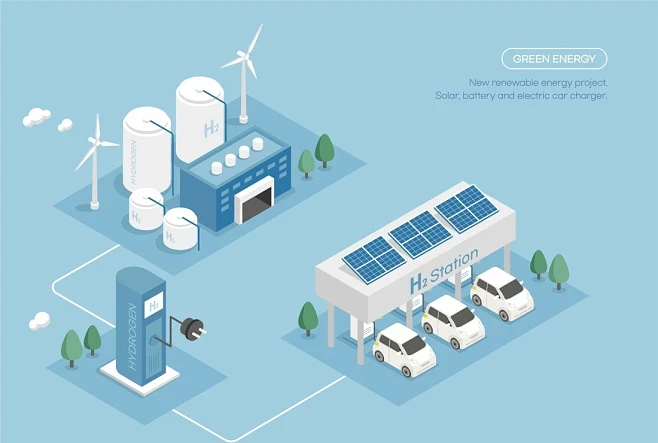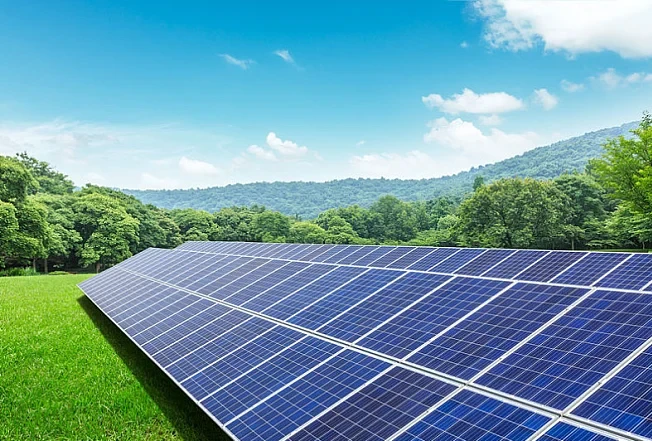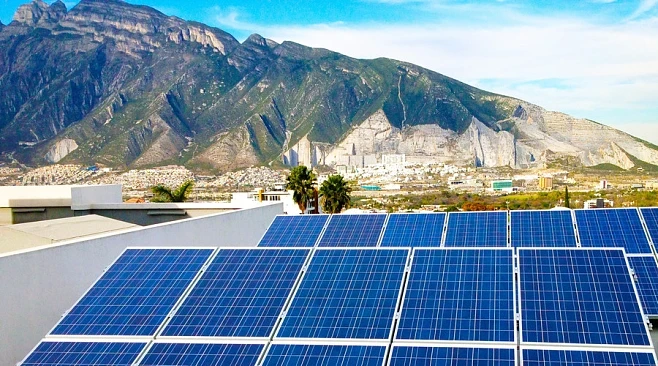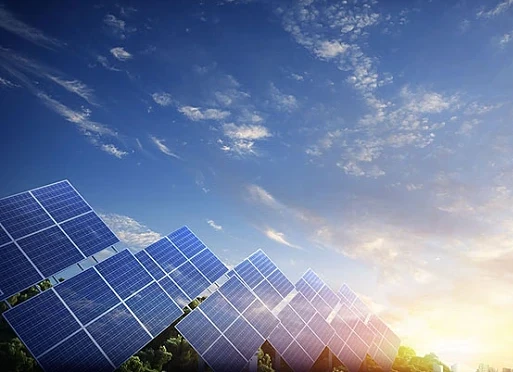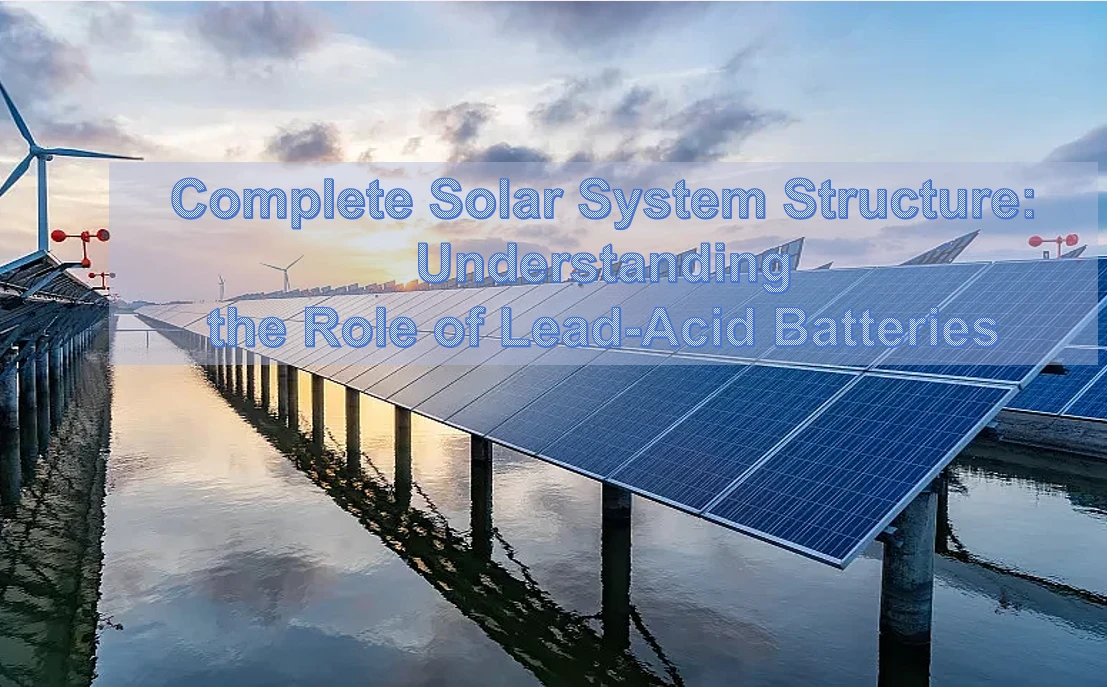
Today, vast momentum exists in producing sustainable and clean energy resources for our further needs while decreasing adverse environmental effects. Solar power systems have also developed into one of the promising solutions to meet these rising demands with less impact on the environment. In this detailed article, we will discuss solar energy system fundamentals and workings, specifically lead-acid batteries that play a vital role within this dynamic ecosystem.
I. Solar Power System Overview
Solar power systems convert the sun’s abundant energy into electricity by capturing the sun’s abundant energy. It offers a sustainable, ecological, and renewable energy source instead of conventional fossil fuels. This overview dives deep into the basics and mechanics behind solar energy systems while shedding light on multiple advantages and applications.
A. Fundamentals and Workings of Solar Energy Systems
Solar energy systems are innovative gadgets that harvest and convert sunlight into usable electricity or heat. It comprises the following components:
- Photovoltaic Cells:They are the most basic components of any solar energy system. Most consist of photovoltaic cells that absorb light and thus produce DC electricity when exposed to light. Normally, they comprise silicon and have been optimized with efficiency in mind to convert sunlight into electricity.
- Inverters: The standard electrical power supply employs AC electricity. However, solar panels generate DC electricity, which needs to be converted to AC if used within households or industries. Inverters take on this responsibility by converting the synthesized power from solar panels into lighting our homes or businesses.
- Solar Batteries:The surplus energy produced during the day can be stored in solar batteries for night or cloudy days. Batteries are important to make solar energy a steady and continuous power supply source.
B. Benefits and Areas of Application of Solar Energy Systems
Advantages:
- Renewable and Sustainable:Solar energy is bountiful and renewable, so it’s an excellent environmental option with lessened dependence on fossil fuels.
- Low Operating Cost:Once installed, solar panels require low operating as well as maintenance costs. Hence, they’re cost-effective in the long run.
- Reduced Electricity Bills:Solar panels reduce electricity bills drastically as they reduce the production of free electricity from sunlight, which takes away the bill of electricity.
- Environmental Advantages: The use of solar energy systems causes no harmful greenhouse gas emissions, so this sums up a much better environment.
Applications
- Residential:Very commonly used in homes for generating electricity and heating water, solar panels provide the clean.
- Commercial:Hundreds of companies take advantage of solar power, thus cutting down on the cost of the energy consumed by them. That shows how dedicated they are toward sustainability.
- Industrial:Widely used in running factories, warehousing, and manufacturing units – solar energy is widely being used.
- Off-Grid Solutions:For electrifying bypassed areas or off-grid areas – solar power is an essential commodity. This enhances supply in poor access areas.
II. Solar Modules
A. Photovoltaic Panels (Solar Panels)
Photovoltaic panels are an important part of the process of converting sunlight to electricity and, therefore, referred to as photovoltaic panels. They work on the basis of the photovoltaic effect, which is an operation under which some materials will emit electrons upon exposure to sunlight and, hence, form an electric current.
Function and Principle:
Most solar panels are primarily made up of silicon. When photons from sunlight strike such cells, they excite electrons inside them so that they can move freely within them. This forms an electrical movement or current that is then collected and converted by an inverter by changing into direct current (DC) from alternating current (AC) for use at home.
Types of Photovoltaic Panels:
- Monocrystalline Panels:Monocrystalline Panels: These panels are made of single-crystal silicon, the most efficient concerning efficiency-wise with a black appearance. Besides this, they prove fit for installations that have less space.
- Polycrystalline Panels:Polycrystalline panels utilize multiple small silicon crystals, slightly reducing efficiency but often providing a more budget-friendly option.
- Thin-Film Panels:For these, thin semiconductor materials are deposited on a substrate. The thin-film panels do not have high efficiency but can be light and flexible in some applications, such as solar shingles and mobile/portable panels.
B. Brackets and Supports
A well-installed photovoltaic panel system should be expected to provide long-term performance and safety. Brackets and support structures serve the purpose of securing the solar panel at one location. Positioning it in such a way as to allow maximum sunlight exposure while offering some protection against adverse effects due to wind, snow loads, or other environmental factors that may become present over its lifespan.
Support and Stability
- Weight Distribution:Solar panels are heavy, and an evenly distributed weight across support structures prevents structural damage.
- Angle Adjustment:Most of the support structure comes along with panel tilt and orientation adjustment mechanisms to angle the panels correctly so that they get sunlight at optimum angles throughout the day.
- Durability:High-quality materials are required as high environmental stressors work on a panel over its entire lifetime. Good construction is also required.
C. Solar Tracker
Solar trackers increase energy production by tracking the sun’s movement and adjusting its orientation accordingly.
Function/Purpose:
A solar tracker constantly realigns the solar panels so they face the sun directly. This maximizes how much light is absorbed, thereby converting it into useful power. This increases overall system output. Sensors and motors achieve this functionality in a solar tracker.
Types of Trackers:
- Single-Axis Trackers:In these trackers, panels move along only one axis. It follows the daily path of the sun.
- Dual-Axis Trackers:Panels that track on both the east-west and north-south axes constitute a dual-axis tracker, maximizing solar exposure effectively during the day and across seasons.
III. Battery Energy Storage System
A. Battery Energy Storage Systems (BESS) in Energy Transition
Battery energy storage systems (BESS) are key to setting up sustainable and reliable energy infrastructure to bridge the transient void between intermittent renewable sources such as solar and wind to constant electricity needs. BESS has diverse critical roles:
- Grid Stability:Solar Batteries, besides stabilizing power grids by storing excess energy when supply exceeds demand and delivering it during peak periods, preventing blackouts and voltage fluctuations from happening, can balance the load grid – also used for demand response programs.
- Renewable Integration: Solar Batteries allow the integration of variables by incorporating renewable energy sources into the grid, creating a steady flow of power even if the weather is bad and there is no wind or sunlight.
- Energy Time-Shifting:BESS store surplus energy at off-peak hours when electricity is cheaper and release it at peak hours when prices are higher to lower energy costs.
- Backup Power:They provide backup power during grid failures so as to increase critical infrastructure and home resilience.
B. Role of Solar Batteries in System Optimization
Lead-acid batteries are prime factors in optimizing solar power systems. At daytime, they store excess energy generated by photovoltaic cells and release it when sunlight is insufficient – during the night or on a cloudy day. This ensures that there will be an uninterrupted supply of steady power from the solar system but less dependency on the grid. The reliability comes as an enhancement through this rising performance.
Adding this subheading makes explicit what function solar batteries have within an overarching context of battery energy storage systems.
C. Different Types of Energy Storage Technologies
Lithium-Ion Battery:
The energy density of lithium-ion batteries is the maximum of all the energy storage technologies due to their efficiency and relatively low maintenance requirements. They are also one of the most popular types of energy storage technology applied in EVs and home energy storage, among numerous other applications. Our JYC Lithium-ion batteries are incredibly efficient.
Lead-Acid Batteries:
It has been used for decades because of its reliability. It has a higher frequency of usage with an uninterrupted power supply (UPS). However, its energy density is lower than lithium-ion batteries as it gives fewer cycles.
Sodium Sulfur Battery:
Sodium sulfur batteries are high-temperature kind batteries that store energy like molten sodium or sulfur. Thus, such kind of battery has great grid-scale applications with much higher energy density and efficiency in the market.
D. Control System and Inverter
Control systems are a basic element in battery energy storage systems charged with the responsibility to oversee, control, optimize, or manage the performance of batteries in order to ensure safe and efficient operations of the batteries. They offer a safe and efficient operation of the batteries. Equally important are inverters that convert DC power stored in batteries into AC that can be used for homes, businesses, or the grid. Inverters help maintain high-quality power supplied while remaining dutifully compatible with the grid.
The integration of the control system/inverter plays an essential part in BESS’s achieving:
- State of Charge (SOC) Management: To monitor charge/discharge cycles for early degradation prevention.
- Grid Integration:Coordination with the grid to reduce fluctuation of demands by feeding excess energy back to the grid.
- Safety and Protection: To make sure that the batteries operate within temperature ranges and voltage limits and disconnect them at fault conditions.
IV. Transmission and Distribution Systems
A. Transmission Line
Transmission lines are an integral part of the smooth and safe transfer of power generated from solar-based energy systems. It can transmit both types, i.e., DC (Direct Current) or AC (Alternating Current).
DC transmission:
It denotes the movement of electricity in a steady stream in one direction: electrical charge over one-way connections. Sometimes used to supply long-distance power produced at remote solar farms to cities, it has fewer losses than AC transmission and is thus more efficient.
AC Transmission:
AC transmission, however extreme, uses reversing currents because the direction of the current reverses periodically. The most common is AC distribution, used in most homes and businesses. It can be easily modified to various voltage levels in order to power may be efficiently fed over short-to-medium distances.
B. Inverter
Inverters form significant components of solar energy systems, which convert direct current.
Function and Principle:
Inverters are the devices converting DC power output from solar panels to AC power that is utilized in homes and businesses. Their duty is a function similar to grid compatibility matched regarding the generated power so it can be either used directly or provided back into the grid.
Types and functions:
- String Inverters: This is most common for residential systems where multiple solar panels connect in series. They are cost-effective and ideal for small installations.
- Microinverters:Installing microinverters on each panel maximizes efficiency per separate panel with improved monitoring capabilities.
- Central Inverters:The central inverters work well in large-scale solar farms at a utility-scale since they handle volumes of high-powered electricity from multiple panels.
C. Distribution System
The distribution system allows the electricity generated by the solar panels to be safely and efficiently distributed to people’s homes, businesses, or the grid.
Switchboards and Protective Devices:
A switchboard acts as a distribution hub: Electricity from the inverter gets directed towards various loads while ensuring proper circuit protection. The electromagnetic devices of protective devices such as circuit breakers and fuses protect people against overloads and short circuits respectively.
Security and Compliance Requirements:
Electrical codes and standards must be adhered to when complying with the law; the safety and reliability of the distributed solar energy demands that installations meet local and national regulations. Besides regular maintenance, keeping the system secure and compliant.
V. Monitoring And Control System
A.Surveillance System
Monitoring data acquisition features prominently in any solar power system’s operations. It involves collecting and analyzing data for optimum performance of a system. Monitoring and Data Acquisition:
Monitoring systems gather data on different parameters of the solar energy system, such as output from solar panels, inverter performance, battery status (if applicable), and environmental conditions. All this information provides a better picture for the evaluation of system health and efficiency.
Importance of Remote Monitoring:
Remote monitoring gives instant access to system data from anywhere; hence, operators can detect problems as soon as they happen. It aids troubleshooting, performance optimization, and early warning with respect to potential issues, hence maximum possible energy production.
B. Control System
The control system of a solar energy system has automatic controls together with optimization functions so that its overall efficiency and capability are improved.
Automatic Control and Optimization:
The control systems use automation to control inverters as well as battery systems, ensuring they run optimally. They change settings per real-time data inputs plus weather conditions and adjustable user-specific parameters to maximize energy production and storage.
Control Strategies and Algorithms:
Among some of the control strategies and algorithms used are:
Maximum Power Point Tracking (MPPT):
This optimizes output from solar panels by forcing a load to seek peak power points.
Grid Interaction Control:
This ensures power is fed into the grid smoothly, taking into account voltage and frequency.
Energy Storage Management:
The control algorithms for battery systems dictate whether or not batteries should be charged, given grid demand and the price of energy.
The Bottom Line
In essence, the whole system is an engineering marvel of science basics and innovation. Every single part has importance in the process, from collecting sun rays to storing clean energy and distributing it for use. Sustainability, being what everyone focuses on these days, makes solar power systems revolutionize our world’s energy landscape. As we continue to use up the sun, this future will be brighter, cleaner, and greener than ever before. Join the solar revolution and let the sun power your world.
For more information on batteries, you can visit the JYC Battery website at



